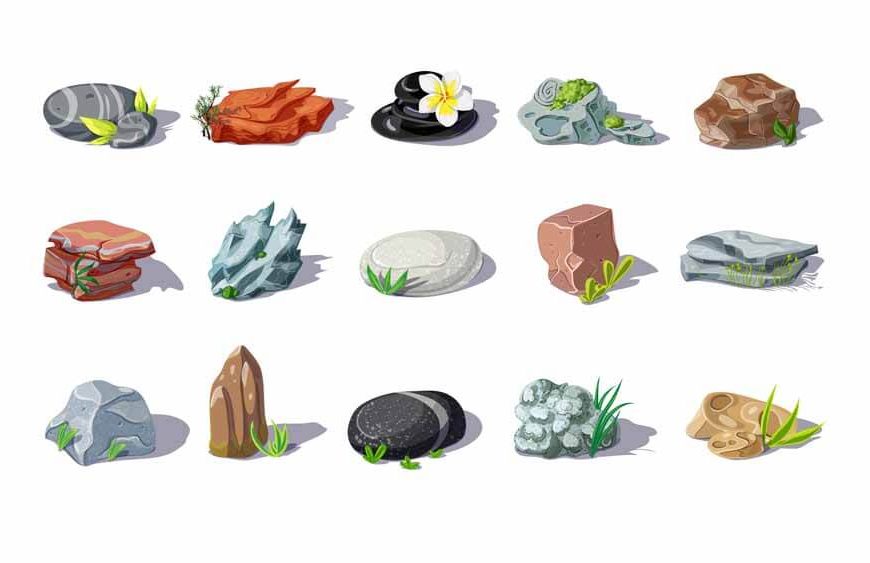Rocks are amazing! Rocks are fascinating natural formations that have shaped the various landscapes of the earth for millions of years. They are present on this earth in a variety of types, each of them with their own unique characteristics and uses. In this article, we will explore the following questions with kid-friendly examples:
- What are rocks?
- What are the uses of rocks?
- What are the different types of rocks?
- How are rocks formed?
What are rocks?
Rocks are solid, naturally occurring substances that make up the outermost layer of the earth called the crust. They are built up of minerals that are the building blocks of rocks. The minerals are stuck together in a solid form, which create the rocks we see and use around us. Rocks come in a variety of sizes, from the tiny pebbles around us to huge mountains over the earth’s surface. Imagine rocks as pieces of a giant Lego set which make up the mountains, valleys, and landscapes around us.
What are the uses of rocks?
Rocks have been essential to human civilization for countless years. Rocks have many practical applications in the world around us.
- Building Materials:
- Jewellery:
- Art and Craft:
- Agriculture:
- Heating and Cooking:
- Crushed Stone:
- Energy Sources:
- Chemical Industries:
- Healing and Wellness:
- Science and Education:
Rocks are used to construct the buildings, bridges, and roads that we see all around us. Rocks like granite and sandstone are popular choices.
Example: Rocks as “bricks” are used to build the houses, just like Lego blocks are used to build a Lego castle.
Precious and semi-precious stones are used to make jewellery. Diamonds, rubies, and emeralds are popular choices.
Example: Jewellery is like the fancy decorations we add to our dolls or action figures to look extra special.
Rocks can be painted, carved, and used to create art and crafts. Children often use rocks as a canvas for their artistic expressions.
Example: Rocks are like blank canvases for creating beautiful paintings and sculptures, just like drawing on a piece of paper.
Fertilisers are used for making plants grow strong and healthy. Fertilisers contain minerals that come from rocks.
Example:Minerals from rocks are like the magical potions that help the plants grow strong and healthy, just like water and sunlight help them grow.
Some types of rocks, like slate, can be used to make stoves, while others like granite are used to make countertops.
Example: Rocks are like the special materials used to make the kitchen where you can cook delicious food.
Crushed stones, like gravel and sand, are used for construction and landscaping activities. They help create smooth driveways and pathways.
Example: Crushed stones are like the tiny stones in the sandbox that are used to build roads for the toy cars.
Rocks like coal and oil shale can be burned to generate electricity or provide fuel for vehicles.
Example: These rocks are like the magical “fuel” that makes our cars start and powers the lights at home and schools.
Limestone is a valuable resource in the chemical industry. It is used to make products like cement, glass, and toothpaste.
Example: Toothpaste that keeps your mouth hygienic every morning and night is made from rocks too!
Some rocks, such as salt and quartz crystals, are used in therapies like salt caves and crystal healing.
Example: Rocks can make us feel better, just like our favourite blanket or toy can comfort us into feeling better.
Rocks are important for scientists and geologists to study the earth’s history, processes, and environment. They help us know about the past.
Example:Scientists use rocks like detective clues to understand the mysteries of the earth, just like detectives use clues to study mysteries in our favourite books.
What are the different types of rocks?
There are three primary types of rocks, each of them with their own characteristics and uses.
- Igneous Rocks:
Igneous rocks are made from molten rock material that cools down and solidifies. Granite and basalt are igneous rocks. Example: Rocks that were once super hot like lava turn into solid rocks upon cooling, just like the popsicles in the freezer that are made from liquid and they harden to become solid for use.
They can be further divided into:
- Intrusive:
- Extrusive:
- Sedimentary Rocks:
- Metamorphic Rocks:
Rocks that slowly cool down under the earth’s surface, like granite.
Rocks that rapidly cool down on the earth’s surface, like basalt.
Uses: Building materials, Geological studies, and dating techniques
Sedimentary rocks are made from the accumulation and compression of tiny particles like sand, silt, and clay. Sandstone, limestone, and shale are sedimentary rocks.Example: Imagine layers of cookies stacked together. Each layer represents a different time in history.
Uses:Building material, fossil reservation and study, petroleum and natural gas reservoirs.
Metamorphic rocks are made from the transformation of existing rocks through heat and pressure deep with the earth. Marble, slate, and schist are metamorphic rocks. Example: Imagine metamorphic rocks as rocks that went through a superhero transformation, like a regular stone turning into a rock with special powers.
Uses: Sculpture and architecture; they can also be used in the production of talc and graphite.
How are rocks formed?
Rocks are formed through a complex process over geological time periods. The three primary types of rocks formed through various processes are igneous rocks, sedimentary rocks, and metamorphic rocks. Igneous rocks are formed from melted rock on or below the earth’s surface. Sedimentary rocks are formed from sand, silt, clay, dead plants, and animal skeletons. Fossils are usually found in sedimentary rocks. Metamorphic rocks are formed through metamorphosis of other rocks under heat and pressure.
Rocks are more than just lifeless formations around us. They have a variety of uses. They are the building blocks of our planet. The wide range of uses that they have make our life better and more interesting. Just like puzzle pieces, rocks fit together to create a beautiful picture of our world. So next time you come across a rock, remember that it might have a very special role in the grand story of our earth.
For more information, visit EuroKids, or visit a centre nearest to you.















